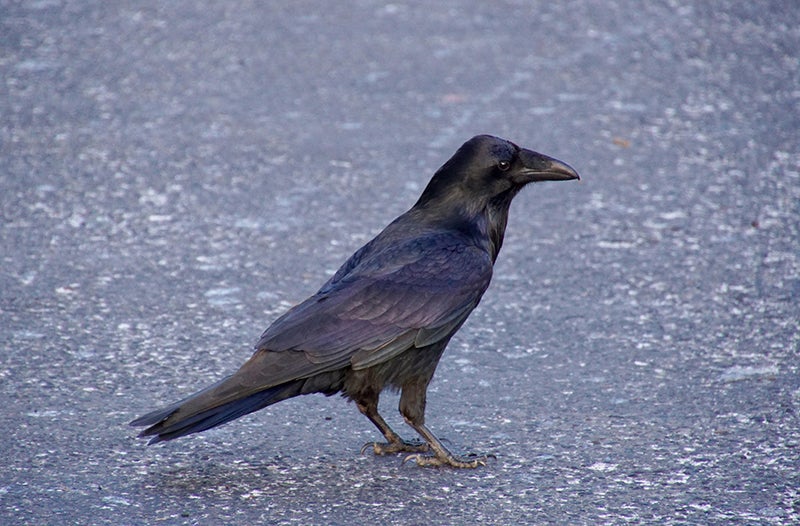Al Batt: Do Cooper’s hawks remain in the Albert Lea area during winter?
Published 9:00 am Saturday, September 9, 2017

- By itself, a raven is just a raven, but when they are in a group they are often referred to as an unkindness. Al Batt/Albert Lea Tribune
Al Batt of Hartland is a member of the Albert Lea Audubon Society. Email him at SnoEowl@aol.com.
My neighbor Crandall stops by.
“How are you doing?” I ask.
“Everything is nearly copacetic. Roses are red. Cardinals are red. Poetry is hard. I’ve been helping my neighbor Gizzard. He Is a recovering dairy farmer. Now he sells honey. Every morning, he goes out to the hives and squeezes the honey out of the bees. Gizzard is a sharp fellow. He has an inferiority complex, but he doesn’t deserve it. He asked me, ‘Why, in a country that guarantees free speech, do I need to pay my phone bill?’”
Naturally
I’ve been pulling bittersweet nightshade, seemingly by the truckload. Bittersweet nightshade, also called climbing nightshade or bitter nightshade is commonly found throughout Minnesota growing along fencerows, in hedges, on plants and waste places. It could choke out desired vegetation. It’s a perennial woody vine with little star-shaped purple flowers with pointed yellow centers and green berries that turn red when ripe. Bittersweet nightshade spreads by seed, but its stem can root as it creeps along the ground. It flowers from May to September. I’m not sure how effective pulling it is, but the tugging and pulling gives me pleasure.
Look at that with these
My old pair of binoculars were so old, they were equipped with a crutch.
I took a number of models for test drives.
Wernher Von Braun said, “One good test is worth a thousand expert opinions.”
When I have my eyes tested, the eye doctor, as I sit in the eye chair, gets my vision down to two choices on the eye thingee that I look through. The eye doctor slides the choices back and forth right in front of my eyes.
“Is this better? Or is this better?” he repeats several times.
I’m dumbstruck. I can’t tell the difference.
“This? Or this?” He reduces his repeated question to a shorthand version.
I finally pick one, but only because I’m forced to. I could live with either.
Binoculars make great birding companions. I’ve never heard one complain about anything. They are amazingly good company. I take them here and there. Not everyone can pull off that look. It’s amazing what you can see just by looking.
As I watched a zone-tailed hawk fly far above me in Arizona, I fell in love with my new binoculars.
Q&A
“What is the largest butterfly in Minnesota?” It is far from common here, but the giant swallowtail is the largest butterfly not only in Minnesota, but also in the U.S. It has a wingspan of 4 to 6.25 inches.
“What bird sings the most?” On May 27, 1952, Louise de Kiriline Lawrence counted the number of songs sung by a single red-eyed vireo on territory north of Toronto. He sang 22,197 songs in the 14 hours from just before dawn to evening, singing for 10 of those hours. That might be the record.
Daniel Otten of Hayward asked how many legs a tick has. In the larval stage, ticks have six legs and an adult has eight legs. This distinguishes ticks from insects, which have six legs. Ticks have the same number of legs as adult mites and spiders.
“I know that a group of crows is called a murder. What is a group of ravens called?” The collective noun I hear most often is an unkindness.
“Why do so many people dislike crows?” Cornell Lab of Ornithology’s Kevin McGowan, a renowned crow researcher, had this to say about crows, “These birds aren’t a gang of nasty villains. These birds are just birds. American crows are among the most family-oriented birds in the world.” I suspect their lack of popularity stems from the fact that they feed on the corpses of farm animals and on the people after a great battle or large die-offs due to disease outbreaks. This caused European mythology to associate crows and their corvid relatives with death and disease. Vultures often fall into the same category in the minds of many people. Not everyone believes they are bad things. Some Tibetan monasteries are famous for performing sky burials. That’s a funeral practice in which a human corpse is placed on a mountaintop to decompose while exposed to the elements or to be eaten by scavenging animals, especially carrion birds like vultures. It is considered a bad omen if the vultures will not eat a body.
“Do Cooper’s hawks remain here in the winter?” Some adults and juveniles do overwinter here, but most migrate. Their population has increased, so we may be seeing more of them lingering here. During the fall migration, the juvenile females migrate first, then juvenile males, followed by adult females with the adult males being the last to leave.
Thanks for stopping by
“To handle yourself, use your head; to handle others, use your heart.” — Eleanor Roosevelt
“You can either grow old gracefully or begrudgingly. I chose both.” — Roger Moore
Do good.


